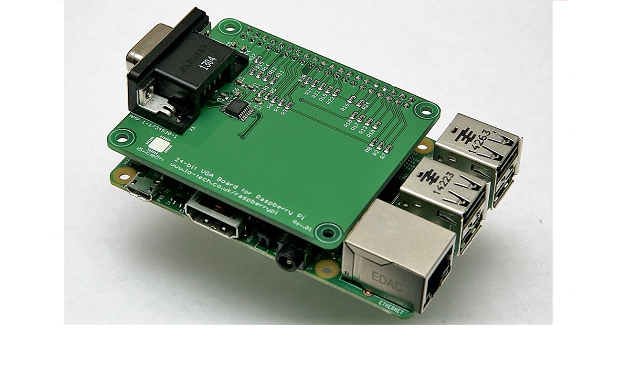
The Raspberry Pi uses HDMI for it’s built-in display interface, and it’s well documented that a second screen can be connected to the GPIO header when switched to ‘display parallel interface’ (DPI) mode. The DPI is powered from the Raspberry Pi’s GPU and so has the same performance and capabilities as the HDMI port – 1080p, 24-bit colour, 60Hz.
Project boards exist already to connect a VGA screen to the GPIO, but these are very simple designs and have some limitations such as 6-bit colour and sensitivity to interference from the wireless peripherals in the RPi 3. The RPi GPIO is also stressed by the TTL control signals in the VGA interface and the project boards lack the certifications needed to be offered as finished products.
The Lo-tech Raspberry Pi VGA Board aims to address these problems, providing a true-colour VGA Adapter in a ‘HAT’ PCB format that will provide a reliable VGA output for primary or secondary display purposes whilst protecting the RPi, both from ESD when the screen is connected hot and from over-stressing the GPIO outputs via buffering of the key control signals.
I’m excited to report that this board has just cleared EMC testing, meeting EN 55032:2015 Class B limits, and ESD testing, passing BS EN 61000-4-2:2009 level 4, and so can be pre-ordered today (first deliveries expected approx. February 2017).


I have a question, but it’s a bit of a weird one.
Since this hat is designed to be on top of the pi it would block airflow and prevent cooling solutions. Would it be possible to get an underside-mount via pogo pins?
I guess this is more of an issue with RPi4 than when this board was originally developed, on an RPi2 which produces very little heat. Maybe it would be enough to reshape the board as an ‘L’?
Yeah, that would do it, but it might compromise the structure a bit since it would lose the 4th mounting hole.
Maybe putting a hole in the middle over the components that need a heatsink so a 40mm fan can be slotted in?
I’d pay double for one that had a low-profile 5v fan header and a fan mount, but I don’t know if there’s enough demand to justify a production run :/
An alternative approach is to mount a fan beside the assembled RPi/VGA-hat, so blowing ‘through’ the sandwich. This allows the use of a bigger, quieter and more reliable fan, of course at the expense of case space. When used as an embedded system, e.g., in an arcade cabinet, that presumably wouldn’t be a problem.
I use this on an old Apple IIgs CRT monitor with a custom 15kHz RetroPie image (and a sync combining circuit, as that monitor uses RGBS sync rather than RGBHV) and it looks phenomenal. The only other 24bit GPIO hat is over $100… I’ll pass! Haha. Anyhoo, just wanted to tell you that this thing is an underrated gem.
Thanks very much for posting – great to hear it’s working well for you!
which image can i use with pi4 for retro games CRT 240p? I already bought your product.
According to VGA standard only 3×8 + Hsync + Vsync = 26 GPIO are needed and then ¿Does this hat uses all 40 GPIO or there are some that can be used for another purpose? This is because I’m interested in this device but I need to add some other components and in this mode RPi cant not use SPI.
Thank you very much.
Hi, the board uses: Blue – GPIOs 4..11; Green – GPIOs 12..19; Red – GPIOs 20..27; plus GPIOs 2 and 3 for HSYNC/VSYNC. That only leaves ID_SD and ID_SC, which I think can be used as GPIOs except on the RPi3.
hi there, I am interested in buying this board to retrofit my vehicle’s display (by adding rpi4 with openauto firmware). input video format must be rgbhv with 800×480 resolution and I am using cheap HDMI to vga converter for this however the image quality leaves much to be desired. Can I use this VGA shield to output above mentioned resolution? I haven’t found this resolution in dpi modes mention in your wiki
This can probably be achieved using dpi_timings but some experimentation is probably needed. You might try “dpi_timings=800 480 48 40 40 3 10 10 28007040” which would be 60Hz with 40 pixel front and back porch horizontal and 10 lines front and back vertical. ChatGPT can probably help you – good luck!
Hi, I was wondering if I could get a 480 signal from this to my CRT. Thanks!
It can run at 640×480 if that’s what you mean?